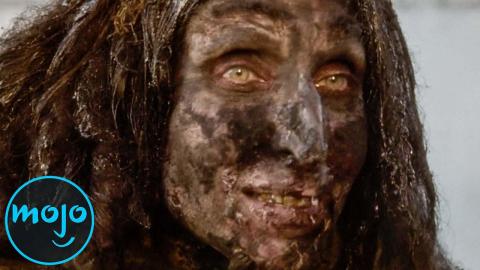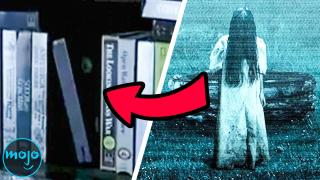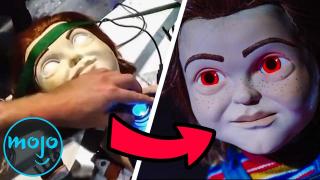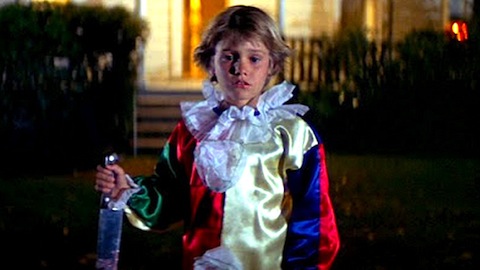Top 10 Mind Bending Horror Movie Scenes

#10: Patrick Confesses
Top 10 Neil Patrick Harris Moments
“American Psycho” (2000) Adapted from Bret Easton Ellis’s novel of the same name, “American Psycho” ends exactly like its source material. Serial killer Patrick Bateman confesses his crimes to his lawyer, Harold Carnes, over the phone. Yet when he meets Carnes in person, the latter not only laughs at the apparent “joke,” he also claims that he recently had dinner with one of Patrick’s supposed victims. The revelation throws the events of the movie into question and puts viewers into Patrick’s raddled and paranoid state of mind. What the heck is going on here? Why is Carnes not taking him seriously? Were the killings real or imagined? Those are all questions that both we and Patrick would love to know the answers to.
#9: Tina’s Death
Tina Fey Biography (UPDATE)
“A Nightmare on Elm Street” (1984) Toward the beginning of this classic, teenager Tina Gray and her friends discuss the freaky nightmares they’ve all been having involving a disfigured man with a knife glove. The shared nightmare is weird enough to capture viewers’ attention, but then things go totally off the rails. In a good way, of course. Tina once again has a nightmare about the man, only this time he violently attacks her. Viewers are then given glimpses of the real world, as Tina’s body levitates off the bed and thrashes around on the ceiling. It’s a mind-warping sequence that establishes a fantastical element to the film, and it really must’ve thrown shocked audiences for a loop back in 1984. With this, Freddy Krueger, the horror icon, was born.
#8: Another Go-Round
Top 10 Horror Movie Scenes That Made Normal Things Scary
“Mother!” (2017) Darren Aronofsky’s “Mother!” is both a biblical and environmental allegory, but it can also work as a straightforward story about unwanted visitors getting out of hand. That is, until the ending, when the allegory takes center stage and all semblance of realism is thrown out the window. “Mother” blows the house up, yet “He” is left curiously unscathed. He then removes Mother’s heart, which contains some type of magical crystal, and seemingly resets the cycle by reverting the house to its idyllic state. It’s a clean slate for God and humanity, and it works as a piece of allegory, even if the rest of it remains largely confounding for most viewers.
#7: Norman Is His Mother
“Psycho” (1960) Everyone today knows that Norman Bates dresses as his mother, Norma, and that Norma is long dead. It’s one of the most famous twists in movie history, if not the most famous. Its cultural legacy speaks to its incredible power. Throughout much of the movie, viewers are led to believe that Norma Bates is the one committing the killings. It’s not until Lila discovers Norma’s mummified corpse in the fruit cellar that the truth becomes known. Norman embodies his dead mother as an alternate personality and kills the women he feels attracted to. Even to this day, it remains an effective and highly disturbing plot twist that establishes Norman Bates as one of cinema’s scariest bad guys.
#6: The Red Coat
Top 50 Scariest Horror Movie Scenes of ALL TIME
“Don’t Look Now” (1973) This horror classic from director Nicolas Roeg follows John and Laura Baxter as they escape to Venice following the death of their daughter. As an often brutal examination of grief, John often sees what he thinks is his daughter throughout the Venetian streets and canals - she’s wearing the same red coat that she was wearing when she died. But when he finally approaches the mystery girl, he discovers that she’s actually a female dwarf who is quick to kill him. Both the viewer and John realize with horror that he’s been having premonitions of his own death throughout the movie. The reveal answers many questions while capitalizing on the eerie and surreal atmosphere of the film.
#5: The House
Top 10 Gravity Bending Movie Scenes
“The Blair Witch Project” (1999) This classic movie begins as a rather straightforward story about students getting lost in the woods and letting their imaginations run wild. But it quickly spirals into a waking nightmare as they’re plagued by what seem like supernatural occurrences. The ending is filled with tantalizing ambiguities like the nature of the house, the distant cries from Josh, and the fates of both Mike and Heather. They’re enacting an old tradition of serial killer Rustin Parr, but his crime spree occurred in the 1940s. So what’s happening here? Is the elderly Parr still alive? Is the witch copying Parr’s methods? Is there even a witch?! We don’t know, and it makes the ending all the more memorable.
#4: Diner Nightmare
“Mulholland Drive” (2001) Really, you could pick any random five minutes from David Lynch’s filmography, and chances are it would be mind-bending to some degree. The creepy Mystery Man from “Lost Highway” is certainly bizarre, but we have to give this spot to the famous diner scene from “Mulholland Drive.” Lynch masterfully shatters the barrier between nightmare and reality by bringing to life the subject of one man’s dream. We obviously don’t expect the creepy person of the man’s dream to appear behind the diner, yet there they are, and their reveal is enough to make your blood run cold. The entire sequence is a masterclass in building tension and paying it off in unpredictable and frightening fashion.
#3: The Sunken Place
Top 10 Behind the Scenes Horror Movie Secrets
“Get Out” (2017) Jordan Peele as a director expertly balances the metaphorical with the literal, and in the process, has become one of the leading names in social commentary. In “Get Out,” Chris is hypnotized by Missy Armitage and sent to a dark void of nothingness called the “Sunken Place.” Taken on a metaphorical level, the Sunken Place represents the voiceless who can both see and hear but can’t do anything to escape their predicament. What might be even more frightening is that this is where the Armitage’s victims are sent in order to remove their consciousness and complete brain transfusions. It’s a mind-bending concept that we wouldn’t wish on anyone to actually experience.
#2: The Hospital
Top 10 Horror Movie Opening Scenes
“Jacob’s Ladder” (1990) One of the most disturbing films of the ‘90s, “Jacob’s Ladder” follows a veteran named Jacob Singer who experiences unsettling hallucinations after returning from Vietnam. After suffering an injury, Jacob is taken to a horrific hospital. In what is arguably the movie’s most famous scene, Jacob sees the likes of deformed doctors, dilapidated and bloodied hallways, and troubled patients who act in unsettling fashion. To make sense of the scene, one needs to consider both the ending and Louis’s story of Eckhart. Jacob is actually dying in Vietnam, and his New York experiences are taking place in his failing mind. It’s heavily implied that the hospital is Hell, and that the doctors are trying to “free” Jacob of his connection to the living world.
#1: The Photograph
Top 10 Best Raunchy Scenes in Horror Movies
“The Shining” (1980) While adapted from Stephen King’s novel, writer-director Stanley Kubrick added his own peculiar elements to “The Shining” and crafted an ambiguous story in the process. Perhaps his most head-shaking invention is the ending. After Jack dies in the hedge maze, the movie cuts to a photo from 1921. It depicts a large group of partygoers, and front and center is Jack himself. Countless theories have been put forth regarding the nature of the photograph, as it throws the nature of Jack’s character into question and introduces yet another supernatural element to the film. As for Kubrick himself, he believed that the photo represents Jack’s reincarnation. As Grady tells him earlier in the film, “You’ve always been the caretaker.”









